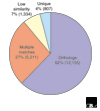The draft genome sequence of the nematode Caenorhabditis briggsae, a companion to C. elegans
- PMID: 14659008
- PMCID: PMC329410
- DOI: 10.1186/gb-2003-4-12-238
The draft genome sequence of the nematode Caenorhabditis briggsae, a companion to C. elegans
Abstract
The publication of the draft genome sequence of Caenorhabditis briggsae improves the annotation of the genome of its close relative Caenorhabditis elegans and will facilitate comparative genomics and the study of the evolutionary changes during development.
Figures



References
-
- Nigon V, Dougherty EC. Reproductive patterns and attempts at receiprocal crossing of Rhabditis elegans Maupas, 1900, and Rhabditis briggsae Dougherty & Nigon, 1949 (Nematoda: Rhabditidae). J Exp Zool. 1949;112:485–503. - PubMed
-
- Fodor A, Riddle DL, Nelson FK, Golden JW. Comparison of a new wild-type Caenorhabditis briggsae with laboratory strains of C. briggsae and C. elegans. Nematol. 1983;29:203–217.
Publication types
MeSH terms
Substances
LinkOut - more resources
Full Text Sources

